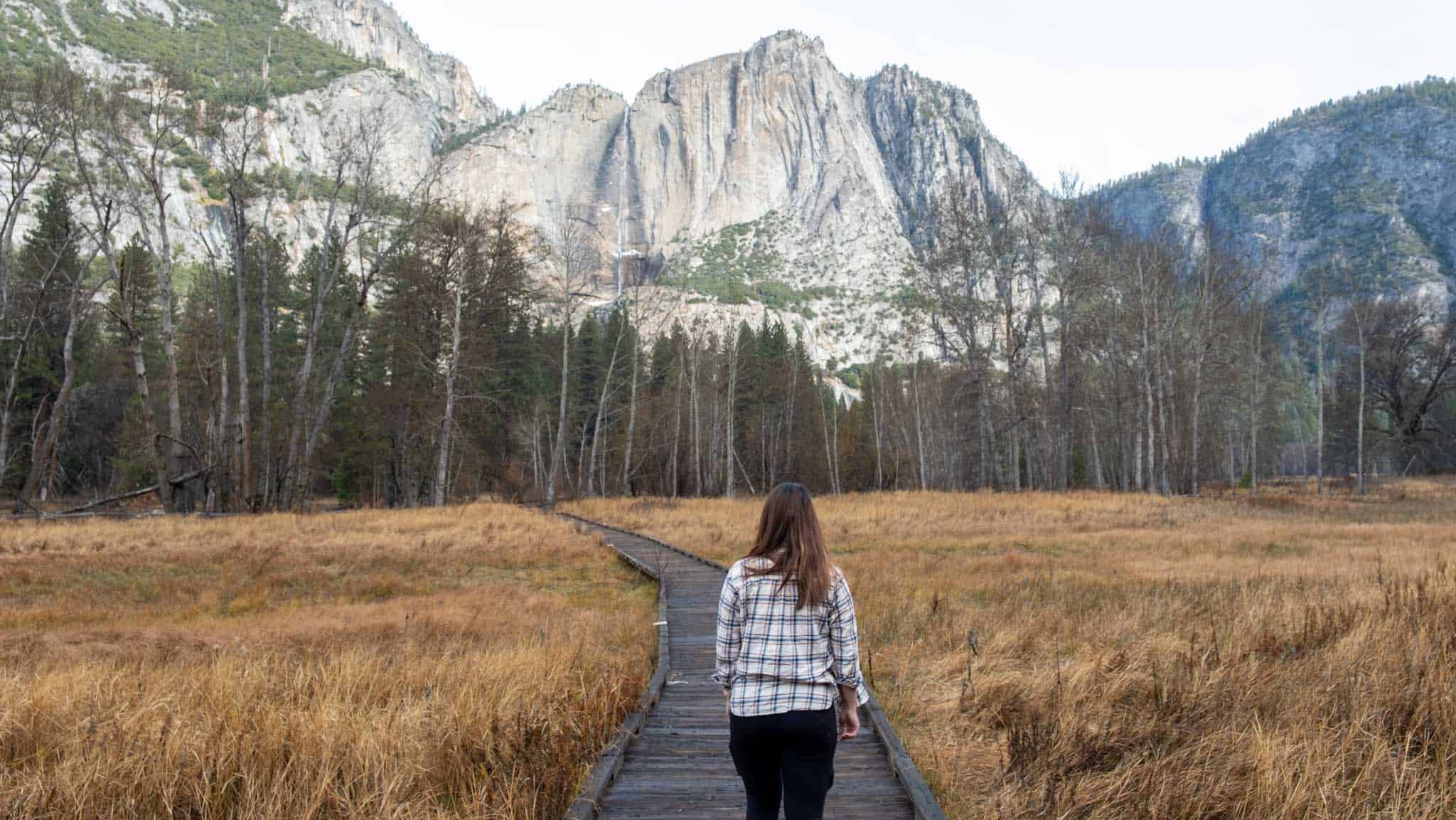Is Bear Spray Legal In Yosemite? Reasons and How To Stay Safe
When you think Yosemite, you think bears. However, is bear spray legal in Yosemite? Surprisingly, the answer is no. It leaves you wondering why, and how are people supposed to stay safe from potential bear encounters?
I’ve camped and hiked in Yosemite National Park multiple times, and also visited other California parks known to have bear activity. There was only once where we possibly came close to a bear encounter in Lake Tahoe – and that was in the middle of the night in our campground vicinity.
One question that always came to mind was – why is bear spray illegal or banned in Yosemite? People I know seem to be pretty relaxed about the topic of bear safety, and are not too worried about a potential attack. Hence, I’ve researched this topic extensively in preparation for an upcoming backpacking trip and to satisfy my curiosity.
I’ll be sharing about why bear spray is banned in Yosemite and ways you can stay safe without it. My hope is for us to be more informed about bear safety and be equipped with the appropriate responses for an incident-free experience in Yosemite.
Disclaimer: I am not a bear expert – though I need to know enough for my backpacking trips. My research is based on official Yosemite website guidelines, learning about people’s experiences on forums, blogs, and Youtube videos. This includes advice from biologists and bear researchers. Don’t rely on this article as guarantee for safety in Yosemite without a bear spray.
Can you take bear spray in Yosemite?
According to National Parks Service, you are not allowed to take bear spray into Yosemite. That includes possession and use of bear spray within the park boundaries.
Is bear spray legal in Yosemite? No – Bear spray is also classified as a weapon, as highlighted in their official website. What I can’t understand is that concealed carry weapons are allowed under a certain pre-approved permit, but not bear spray.
It’s not clear what the fine, and I haven’t heard of any enforcements or TSA-like check on visitors. Despite no known enforcement, it’s worth paying attention to this rule because there might be a “greater good” it serves.
Regardless, discharging of any weapon including bear spray is illegal under federal laws.
Why did Yosemite ban bear spray?
You might be thinking, what’s wrong with bringing along bear deterrence? It’s allowed in many other states and National Parks, so why is bear spray prohibited in Yosemite National Park?
Bear safety rules vary in different localities, so it’s important to check for specific guidelines. I found this Facebook thread quite useful for understanding Yosemite’s rules in addition to the official website.
Bear spray is not needed for black bears
Yosemite has only black bears who are very shy and avoid confrontation unlike their grizzly counterparts. They are known to be easily scared off if you simply yet and them loudly. Since the 1980s, there have only been 15 bear attacks in Yosemite National Park
Some might even say that bear spray is an overkill when dealing with black bears. That said, there are some safety tips you need to know, which I will talk about later.
Most advice around carrying bear spray to other National Parks involve Grizzy bears. However, they are no longer found in California, as the last one was shot in the 1920s. Ironically, the grizzly bear is featured on the California flag.
Improper use of bear spray may cause issues – it’s not bug spray!
Most black bear encounters in Yosemite do not warrant the use of bear spray. However, humans are usually “trigger-happy” and fear usually causes us to take extreme measures if we have the means to.
Bear spray is meant as a last resort to deal with a charging bear. It is not a way to shoo away a passive bear like you would with bug spray. It’s also possible that a bear could be provoked by the bear spray and approach you with curiosity or aggression.
In addition, using bear spray on objects could even attract bears’ curiosity as it has a strong scent. There are stories of people waking up to bears sniffing around their tent because of the person had sprayed their belongings in hopes of “repelling bears”.
Banning bear spray also prevent humans from using this as a weapon against each other in the parks. Even if it’s an accident, the effects of bear spray will be very annoying and painful to people nearby.
After all, there are way more people than bears in Yosemite National Park. It will be a problem if people are ignorantly using bear spray any time they see a bear.
Is it common to see bears in Yosemite?
Contrary to popular belief, bears are not a common sight in Yosemite. However, they are lurking somewhere and waiting for their opportunity to sneak into your unwatched food stash.
There are about 300 to 500 bears roaming around Yosemite National Park, which is not a lot considering the size of the entire park. However, the bears are smart enough to know that Yosemite Valley is a great source of food since most campers and visitors hang out there.
The bears are quite shy and are known to avoid humans. That said, it’s worth taking the same food storage precautions to avoid attracting the bears unnecessarily.

How do you stay safe from bears in Yosemite?
Being bear aware benefits both you and the bears in Yosemite, so that the bears are kept wild and maintain minimal interaction with humans. Here are some essential things to know along with what you should know about bear attacks in Yosemite.
Is it safe to hike without bear spray?
It can be safe to hike without bear spray since black bears rarely become aggressive if they are not startled or provoked. They also prefer to keep a distance from humans, such that you won’t need to use a bear spray since they’re meant for close range aggression, typically 20 to 30 ft (6 to 10 m) away.
That said, sometimes accidents can happen and bear spray might not even help. I came across a blog post where someone stumbled upon a black bear around a blind corner.
Due to the surprise element, the bear swiped at that person’s face resulting in some injuries. However, it was noted that the bear moved away promptly after that and there were no further interactions.
Hence, we should talk about ways to avoid such close encounters in the first place.
How to avoid bears in Yosemite
Now that we know black bears in Yosemite aren’t excited about meeting humans, let’s help them out by making our presence known.
Firstly, we can avoid wearing clothes or perfumes with a strong scent. Bears have a keen sense of smell, and anything out of the ordinary will attract their curiosity.
Next, making some noise periodically, especially when approaching bends and blind corners. This helps to give the bears a heads up so that they can move away in time. Something simple like a “hey bear” or singing out loud could help.
Last but not least, don’t leave food unattended. Most of the time black bears approach areas with humans because of the food they leave behind. If you’re camping, make sure to use bear bins provided at developed campsites, or bring a bear canister for the backcountry.
As a bonus tip – if you notice fresh bear droppings/scat, consider taking a detour to avoid a bear encounter.
What to do when you see a bear?
You might still run into a bear unexpectedly on a trail, and will need to know how to respond appropriately.
If you see the bear but it does not see you, back away and make your presence known
Keep a safe distance from the bear and back off at least 50 yards (45 m) away. Clap your hands and make some noise to let it know you are there and wait patiently for it to move away. If it doesn’t leave, you may want to take a broad detour or backtrack to avoid getting close to the bear. Importantly, do not go between or near a mother and her cub(s).
If you see the bear and it sees you, back away and give it a way to escape
Back away slowly and avoid eye contact so the bear knows that you are not a threat. You can also wave your hands to let the bear know that you are a human. It will probably be spooked by the sight of a human and leave.
Sometimes black bears do a bluff charge where they try to intimidate you. However, this often doesn’t mean they will attack you. In fact, this is a sign of their nervousness and you should avoid escalating the situation. Continue backing off, after which they’ll probably decide you’re not a threat and leave. Here are more tips on how to respond if a bear bluff charges you.
If the bear is approaching you or your campsite, scare it off by acting aggressively
Black bears are not aggressive but they are sometimes curious, and are likened to big squirrels instead of their grizzly counterparts.
If a black bear starts approaching you on the trail, it’s time to make some noise to scare it off. We want to give the bear an unpleasant experience meeting humans, while not harming it.
Similarly, they shouldn’t be comfortable in human territory including campsites. Hence we want to reinforce a negative experience for them as they enter developed spaces.
- Shout assertively and aggressively to scare off the bear (see ranger’s demonstration)
- Stand tall and don’t turn your back on the bear
- Raise your arms and wave hiking poles if it helps, keeping your actions confident and deliberate
- Do not approach the bear, and give it a way to escape
- If in a group, stand together to look bigger but avoid making the bear cornered
- If you have kids, make sure they’re not running around as it might trigger the bear’s chase instincts
Here’s an interesting video of a black bear bluff charging a couple of campers in Kings Canyon National Park. You’ll notice that the bear ran off after they started yelling and shouting, rather than when they were talking calmly to it. As you can see in the comments, people have lots of opinions about how to react in bear encounters.
I’ve also heard of people using air horns to chase bears away from campsites. I wonder if a personal safety alarm works just as well if you’re face to face with a black bear.
If all fails, don’t run and just fight back. Don’t bother climbing a tree as black bears are great climbers. Remember to report your bear encounter to park rangers so that appropriate measures can be taken.

Ensure proper food storage
Since most bear encounters and injuries are related to improper food storage, this is the most important thing to be aware of. In the earlier video I shared, it’s not clear whether they had accidentally attracted the bear with their food traces.
Using bear-proof boxes and bins in campgrounds
If you are camping in Yosemite, developed campgrounds like Upper Pines and Camp 4 will have designated bear boxes and trash bins. It is important to leave all scented items in the bear boxes instead of in your tent if you don’t want to wake up to a bear sniffing around you.
As bears are smart, they can learn to retrieve calorie-dense food from humans just like squirrels. When you’re not within arm’s length of your food, remember to put it away in the bear boxes to avoid attracting these opportunistic bears.
The more difficult it is for bears to obtain food from humans, the lower the likelihood of them getting into human territory and becoming a threat.
Are bear canisters required in Yosemite?
If you’re camping in the backcountry where there aren’t designated bear-proof boxes, you’ll need to store your food and scented items in a bear canister. It’s one of the most important things to bring to Yosemite for backpacking.
They are designed to be difficult for bears to open, and they will just give up on it eventually. It should be stored 100 ft away from your campsite, and 100 ft away from where you’ve cooked. You can think of it as a triangular set up between your sleeping, cooking, and food storage areas.
If you don’t have your own, you can rent a bear canister from various outdoor shops like Sports Basement or even within Yosemite National Park.

Do you need bear bells in Yosemite?
You don’t need bear bells in Yosemite because bears can’t really hear them until you come close enough. Besides that, some people find bear bells annoying, but that’s the only downside I can think of. Using your voice is the best way to let bears know you’re approaching.
Black bears in Yosemite vs Grizzly bears (outside California)
To make things simple, you’ll only be seeing black bears in Yosemite. However, it’s worth knowing about the differences between black bears and grizzly bears, which are commonly found outside California.
Did you know that you shouldn’t identify bears purely from their fur color? In fact, both black bears and grizzly/brown bears can come in shades of brown to black.
The best way to identify a black bear from a grizzly bear is from their physical shape.
- Black bears don’t have a humped shoulder, while grizzlies do.
- If you see pointy ears instead of rounded, that’s a sign of a black bear.
- Looking at their faces, black bears have a flatter profile, whereas grizzly bears have a concave face shape.
You could also try to guess the type of bear based on the paw prints. A black bear’s toes form an arch around the foot, compared to the straight toe line of grizzlies.
Grizzly bear presence warrants carrying bear spray as a requirement, but not so much for black bear territories.
Here’s a catchy guideline to remember. If it’s black, fight back. If it’s brown, lay down (on your stomach, feet flat, and hands clasped over your neck).
Main takeaways: Staying safe without bear spray in Yosemite
- Bear spray is not allowed in Yosemite
- Yosemite only has black bears who are like big squirrels and are easily scared off by yelling
- Since 1980, there have only been about 15 bear attacks in Yosemite National Park
- Make noise and look big to scare bears away if they enter developed areas and campsites
- Don’t run away from a bear, or try to climb a tree
- Keep at least 50 yards away from bears when you encounter them on trails
- Don’t corner bears – give them space to leave or escape and leave a mother bear’s cubs alone
- Ensure proper and strict food storage
More of my travel guides to help you plan your classic California experience
Lassen Volcanic | Lake Tahoe | Yosemite | Point Reyes | San Francisco Day Trips | Half Moon Bay | Pescadero | Big Sur | Santa Cruz | Monterey | Carmel-by-the-Sea | Catalina Island | Death Valley | 10-day California Road Trip | Rental car tips | Bay Area Must-Visit Places
Not sure where to start? I have some ideas for your California trip!
Best stops along California’s coast | Must-go for outdoor lovers | Best winter camping | Bucket-list backpacking trips | Best SF Bay Area hikes | Best California Glamping | Best beach towns







